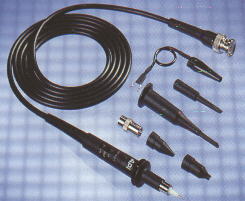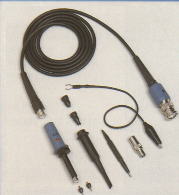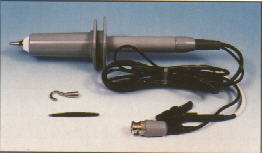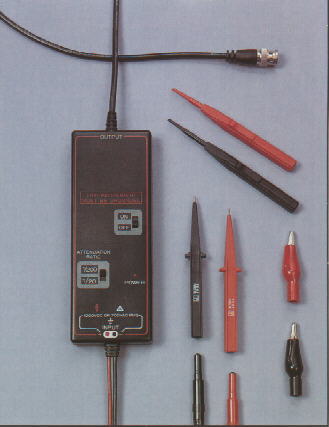General Test & Measurement Accessories
Allison Technology Corporation
General Test & Measurement Accessories
Introduction
The standard laboratory oscilloscope provides voltage measurements relative to the oscilloscope ground, usually the 3rd prong on the AC socket. This is true for the O-Scope and Pico units as well where the computer or an attached peripheral is plugged into the AC wall socket. A few, primarily LCD handheld scopes offer isolated channels providing isolation up to 600VAC.
Some dual channel units offer the ability to combine channels into a single differential measurement at fairly low voltages but such measurements are usually a little difficult to setup properly.
Using the right probe is more than just convenience. It can also be a matter of safety and accuracy. Voltages beyond just a few tens of Volts can be hazardous to equipment and can be deadly to users.
There are a variety of probe accessories which are useful in many applications. Two of the most common are high voltage probes and differential probes. High voltage probes are useful for measuring voltages beyond the standard input range for the oscilloscope. Differential probes offer the ability to measure voltages between two points that are relative and not tied to ground.
ATC will be glad to special order TPI and API probe products for its customers. If you need a probe which is not described here, contact us with the details and we will be glad to check with our suppliers as to price and availability.
Understanding the Specifications
Voltage
Probe voltage specifications are given in the maximum voltages allowable.
This maximum voltage can consist of both a DC (direct current) part and an
AC (alternating current) voltage. Some signals have only AC or only DC values
while others have both, an AC signal riding on top of a DC voltage. For
the most common type of AC signal (a sine wave), the peak voltage is 1.414
times the Vrms (Vrms is the normal way to describe AC voltage). That means
for a 100 VAC (rms) signal, the peak voltage is actually 141 Volts.
Attenuation
Probes are attenuating devices. They are usually rated in terms of
attenuation by using the value Xn, where n may be 1, 10, 20, 100, 200, or 1000.
An X1 probe means no attenuation, like a piece of wire. The most common
attenuating probe is the X10 which divides the signal seen at the tip by 10
by the time it reaches the BNC connector at the oscilloscope. Most probes
are switchable between X1 and X10.
There are three important and different reasons to use an attenuating probe.
The first is to reduce the voltage to a level that can be handled by the
oscilloscope. An O-Scope II which can handle 30 Volts peak using an X1
probe can view up to 300 Volts peak when using an X10 attenuating probe. The
second reason is signal loading. While an oscilloscope has a rather high
input impedance of 1 MegOhm, there are signals which are also of very high
impedance where the 1 MegOhm load added to the circuit can affect the
operation of the circuit as well as the signal being viewed. An X10 probe
reduces the loading by increasing the impedance of the oscilloscope input
by 10 times from 1 MegOhm to 10 MegOhms (and the capacitive AC load of the
oscilloscope is also reduced). The third reason for attenuating probes is
the expansion of the usable frequency range (from reducing the capacitive
AC load). Most probes are useful only up to a maximum of 6 to 20 MHz in the
X1 mode.
Frequency Response
Probe frequency response is normally specified for the maximum attenuation
of the probe. That means that for a switchable X1/X10 probe, it is specified
for X10. Most X1 probes are useful only up to a maximum of 6 to 20 MHz.
In the X10 mode the same probes may be good for 60 to 350 MHz. X100
probes are seldom switchable and are usually X100 only. Most of these probes
are good for use to 100 MHz or even up to 250 MHz depending on the model.
For frequencies beyond 200-300 MHz, it is necessary to use other types of
devices and approaches. Active FET probes may be used or simply going to
50 Ohm inputs and cabling can be used.
HIGH VOLTAGE PROBES
Most oscilloscope probes can handle up to an absolute peak of 600 Volts.
These are virtually always intended to measure voltages relative to ground
(usually a 3rd prong AC wall socket).
Measuring high voltages, usually beyond 110VAC single phase is usually best
handled with specialized high voltage probes.
DIFFERENTIAL PROBES
HIGH VOLTAGE PROBES



ATC offers three high voltage probes. These are the API x100 probe, good
for up to 600 V peak, the TPI M15X100B, good for up to 2000V peak, and the
TPI HV15HF 1000x, good for up to 15,000 V peak. These probes measure
voltages relative to ground but do allow for very high values. The API and
TPI X100 probes offer high frequency capabilities of 100 MHz or greater.
The TPI HV15HF is good for frequencies up to 5MHz with reduced maximum
voltages.
| Model | Atten. | Length (meters) | Max. Freq. | Max. V |
| API 510-100-2A | x100 | 2 | 100 MHz | 600 V Pk |
| TPI M15X100B | x100 | 1.5 | 250 MHz | 2000 V Pk |
| TPI HV15HF | x1000 | 1.5 | 5 MHz | 15,000 V Pk |
DIFFERENTIAL PROBES

Differential probes are available in two distinct areas of measurement.
These are the low voltage differential probes and high voltage differential
probes. High voltage differential probes are used to measure voltages of
several hundred to over 1000 Volts. The low voltage differential probes
are used primarily to measure extremely low signal levels, often in the
microvolts, up to moderate levels of several volts.
High Voltage Differential Probes
High voltage differential probes are very useful in measuring moderately
high voltages found in industrial environments. They are excellent for
measuring power systems, especially multiphase voltages. Using the
differential probe improves both the accuracy and safety of making
power system measurements. They allow a nonisolated oscilloscope to
make voltage measurements that may not be relative to ground, like measuring
multiphase power. Also, the differential measurement requires only one
oscilloscope channel.
Using a high voltage differential probe is a very good idea for those who must work with power systems on a regular basis, even those who work with 110VAC on a regular basis should consider acquiring a high voltage differential probe for SAFETY as well as for the protection of equipment and the convenience of use. Those who work regularly with multiphase power systems and motors should consider the possible benefit of acquiring two differential probes to allow the viewing of two phases at one time.
ADF25 / ADF25A
ATC offers two versions of a high voltage differential probe. These are the TPI ADF25 and the TPI ADF25A units which can measure up to 1400 V and up to 700 V peak signals, even when the measurements are for voltages that are above ground by hundreds of volts. These two units are essentially identical except for the attenuation factors and peak voltages.
ADF25 / ADF25A Specifications
| ADF25 | ADF25A |
| Bandwidth | DC-25MHz | DC-25MHZ |
| Attenuation | 20:1, 200:1 | 10:1, 100:1 |
| Input Resistance | 4M Ohm | 4M Ohm |
Input Capacitance
(each side to ground) | 10pf | 10pf |
| Maximum Diff. Input V | +/-1400 VDC+AC Pk. | +/-700 VDC+AC Pk. |
| Maximum V to ground | +/-1000 VDC+AC Pk. | +/-700 VDC+AC Pk. |
| Common Mode Rejection | -86dB @ 50Hz | -86db @ 50Hz |
| (Typical) | -56dB @ 200kHz | -56dB @ 200kHz |
| Output Voltage | +/-7VDC+AC Pk. | +/-7VC+AC Pk. |
Output Offset Voltage
(-10 to 40 deg. C) | < +/- 5mV | < +/- 5mV |
| Accuracy | 2% | 2% |
| Power Requirements | Four AA (1.5V)
internal batteries or 6VDC
Adapter (not supplied) | Four AA (1.5V)
internal batteries or 6VDC
Adapter (not supplied) |
| Size | 6-1/2" x 2-1/2" x 3/4" (Approx.) | 6-1/2" x 2-1/2" x 3/4" (Approx.) |
| Weight | under 10 ounces | under 10 ounces |
(Calibration to NIST available as option)
Low Voltage Differential Probes
ATC Low Voltage Differential Probe Offerings
ATC currently does not offer a low voltage differential probe. There is one in the prototype phase of design so contact ATC Engineering Dept. for information as to future availability.
Return to ATC Home Page